Status Type Format
A status type's format defines the information that the type addresses or is intended to communicate. You can set up a status type with one of the following formats:
|
Name |
Description |
Examples |
|---|---|---|
|
Date |
Date |
Date a survey was completed. Date of the most recent disaster exercise. Date of a Hospital Preparedness Program (HPP) site visit. |
|
Multi |
Multiple choice; each option is a status |
ED Status: Open, Closed, Open with limitations ED Wait Time: Green, Red, Yellow Neurosurgeon Available: No, Yes |
|
Number |
Status communicated via a number |
Number of ICU beds available. Number of doses available for a medication. |
|
Text |
Textual response |
Name of the infection control officer. Facility's area code. |
|
NEDOCS Calculation |
Computed value based on variables the user enters, including number of patients awaiting ICU beds and acuity of current patients |
- |
| Calculated | Computed value defined by an equation that uses existing numeric status types as variables | Total ICU Beds = ICU Beds + PICU Beds + NICU Beds |
Number
For a Number status type, you have the option to include a summary total row in Views that include the status type. When configuring the status type, select the Display Summary Totals checkbox to enable this feature.
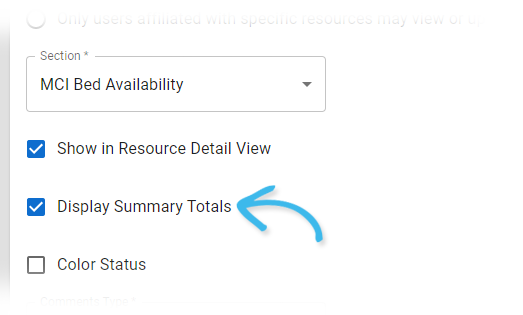
When enabled, the Summary row appears in the appropriate Views, and in Resource Type sections that contain at least one Number status type. The total for that status type appears at the bottom of the list of values.
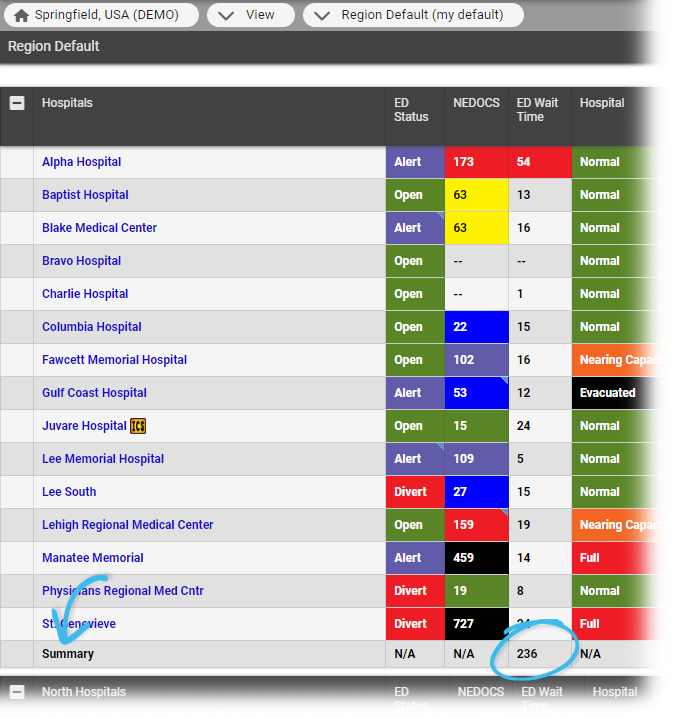
For status types that are not the Number format, the summary row shows N/A.
Calculated Status Types
Calculated status types are values that are derived from an arithmetic equation of existing status and standard status types. For example, total ICU beds is a calculated status type that is derived as the sum of adult ICU beds, PICU beds, and NICU beds.
The configuration of calculated status types differs from other status types in the following ways:
-
Calculated status types cannot be manually updated. Instead, calculated status types are automatically recalculated in real time when any of the component status types are updated
-
Calculated status types do not expire or have reset settings.
Status Timer
If you select Multi as the status type's format, set up one or more statuses; these are the options from which the user chooses when they update this status type. You can set up a timer for any status. This timer can count up or down to an expiration threshold or simply record the time that has passed since the status was changed.
In most cases where you use a timer you will also indicate an expiration interval in the Status Update Frequency field. You can also specify that, upon expiration, the system automatically changes to another status (Upon expiration, auto change status to) and, potentially, resets the associated comment.
You can choose from the following options:
-
No Timer - there is no timer for this status
-
Count down to expiration, then stop counting - starts at the upper end of the interval and counts down to zero
-
Count down to expiration, then count up - starts at the upper end of the interval and counts down to zero; upon reaching zero, it starts counting up
-
Count up to expiration, then stop counting - starts at zero and counts up until the expiration threshold is reached
-
Count up to expiration, then start counting up again from zero - Starts at zero and counts up; upon reaching expiration, the counter starts over from zero
-
Count up (regardless of expiration) - shows how long the resource has been on this status regardless of when it expires
If you set a timer for the status, you may also want to indicate when the timer is reset (Reset Timer).
Color Coding
When you color code a status type, its values appear in the indicated color on the appropriate View pages. For a status type that is a number, you can color code the value based on where it falls in specified ranges. In the following example, a NEDOCS Calculation appears in purple when your ED is overcrowded and green for normal operations or when slightly busy.
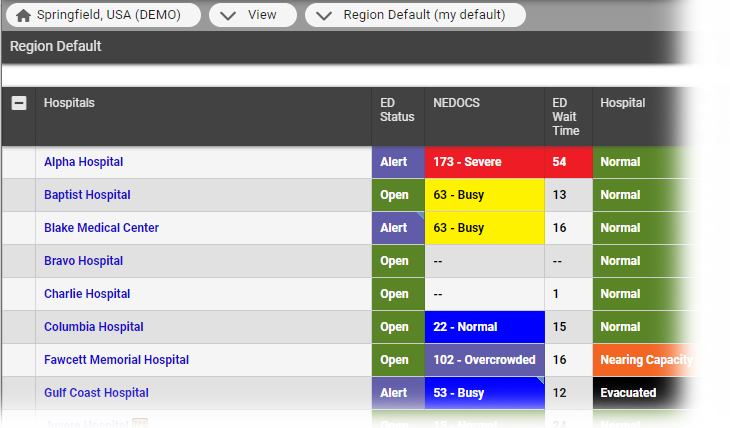
When you create or edit a number or NEDOCS Calculation status type, you can specify color coding. In the following example, the administrator has specified the ranges and the color for each.
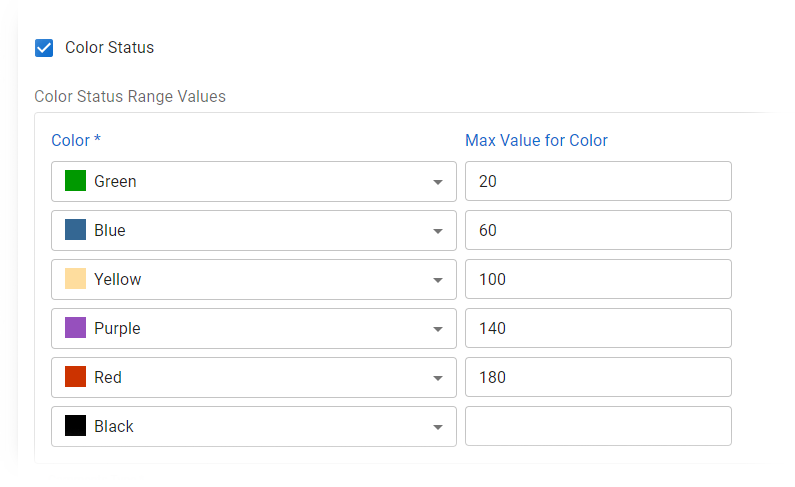
Based on the example above, if the calculated NEDOCS is 62, the number appears in yellow on View pages.
NEDOCS Labels
If your organization reports NEDOCS, the status value shows both the calculated score and an associated descriptive label. Your organization has the option to turn off the display of these default labels.
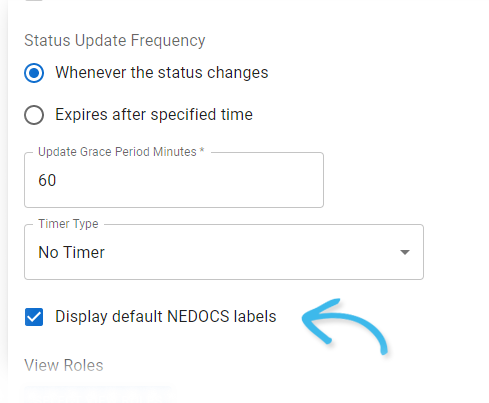
When turned off, the labels do not appear in EMResource views, maps, or associated Update Status pages.
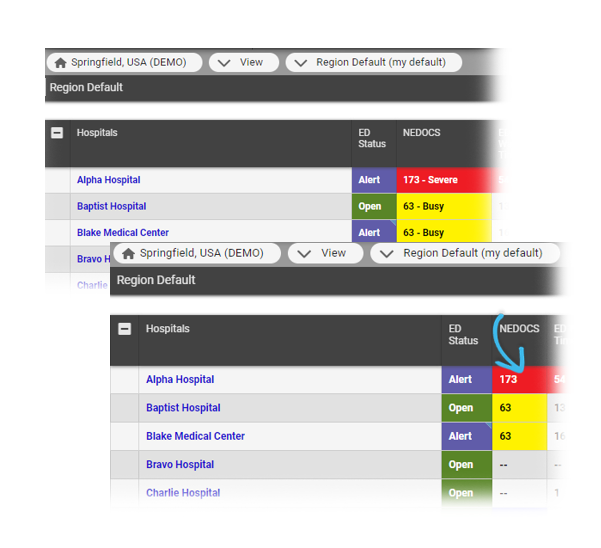
Dashes
If the status for a resource contains dashes (--) it may have expired and may need to be updated. Place the cursor over the status; a pop-up window opens showing the date and time of the last update and indicates whether it is overdue.
User Preferences
Users can specify preferences for receiving notifications about changes to specific resource's statuses. Notification preferences can be set for any type of status type, such as number, text, multi-option, and NEDOCS Calculation. Users specify how they are to receive these notifications--by email, text pager, and/or Web (EMResource). Administrators can also specify these preferences for users they manage.